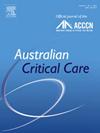新生儿重症监护病房中父母特有的创伤后应激障碍
IF 2.7
3区 医学
Q2 CRITICAL CARE MEDICINE
引用次数: 0
摘要
将婴儿送入新生儿重症监护病房(NICU)的经历对父母来说可能是高度创伤的,可能导致创伤后应激障碍(PTSD)的症状。尽管新生儿重症监护病房的经历会对患者的情绪产生重大影响,但根据《精神疾病诊断与统计手册》第五版(DSM-5)的自我报告工具,新生儿重症监护病房父母中可能出现PTSD的患病率尚未得到广泛的记录。这项研究的目的是解决这一差距。目的本初步研究的目的是评估NICU父母在12个月内的5个时间点可能的PTSD患病率。第二个目的是确定母亲和父亲之间可能的创伤后应激障碍的差异。方法采用DSM-5标准PTSD自我报告检查表对新生儿重症监护病房入院、出院及婴儿矫正年龄3、6、12个月时可能出现PTSD症状的父母进行筛查。截止评分≥31分确定可能为PTSD。结果共有102名家长参与本研究。入院时,13%的新生儿重症监护室父母符合可能的PTSD诊断标准,母亲报告PTSD症状的可能性是父亲的两倍。大多数家长都康复了。关键的一部分家长(6%)在12个月时报告了可能的创伤后应激障碍的严重和持续症状。结论新生儿护士使用DSM-5中的PTSD检查表有助于识别父母压力或创伤的潜在迹象。进一步的研究必须评估早期筛查和转诊是否能改善父母的结果。本文章由计算机程序翻译,如有差异,请以英文原文为准。
Post-traumatic stress disorder specific to parents in the neonatal intensive care unit
Introduction
The experience of having an infant admitted to the neonatal intensive care unit (NICU) can be highly traumatic for parents, potentially leading to symptoms of post-traumatic stress disorder (PTSD). Despite the significant emotional impact of the NICU experience, the prevalence rates of probable PTSD among NICU parents, as measured by validated Diagnostic and Statistical Manual of Mental Disorders, Fifth Edition, (DSM-5) self-report instruments, have not been extensively documented. The aim of this study was to address this gap.
Objective
The aim of this pilot study was to assess the prevalence rates of probable PTSD in NICU parents at five time points over 12 months. A secondary aim was to identify differences in probable PTSD between mothers and fathers.
Methods
The standardised PTSD Checklist for DSM-5 self-report measure was used to screen parents for symptoms of probable PTSD at the NICU hospital admission, discharge, and 3 months, 6 months, and 12 months of infant corrected age. Probable PTSD was identified with a cut-off score ≥31.
Results
A total of 102 parents participated in the study. At hospital admission, 13% of NICU parents met the criteria for a probable PTSD diagnosis, with mothers being twice as likely as fathers to report PTSD symptoms. The majority of parents recovered. A critical subset of parents (6%) reported severe and persistent symptoms of probable PTSD at 12 months.
Conclusions
The use of the PTSD Checklist for DSM-5 administered by neonatal nurses can help identify potential signs of parental stress or trauma. Further research must assess whether early screening and referral improve parental outcomes.
求助全文
通过发布文献求助,成功后即可免费获取论文全文。
去求助
来源期刊

Australian Critical Care
NURSING-NURSING
CiteScore
4.90
自引率
9.10%
发文量
148
审稿时长
>12 weeks
期刊介绍:
Australian Critical Care is the official journal of the Australian College of Critical Care Nurses (ACCCN). It is a bi-monthly peer-reviewed journal, providing clinically relevant research, reviews and articles of interest to the critical care community. Australian Critical Care publishes peer-reviewed scholarly papers that report research findings, research-based reviews, discussion papers and commentaries which are of interest to an international readership of critical care practitioners, educators, administrators and researchers. Interprofessional articles are welcomed.
 求助内容:
求助内容: 应助结果提醒方式:
应助结果提醒方式:


